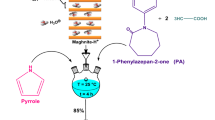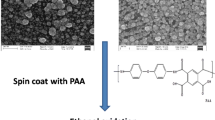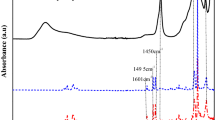Abstract
This study concerns investigations of catalytic activity of heteropolyacids: H4SiW12O40 and H5PMo10V2O40 and their cupric and ferric salts deposited on conducting polymer supports: polypyrrole (PPy) and poly(N-methylpyrrole) (PMPy). Redox and acid–base properties of these catalysts were determined using a catalytic test reaction––conversion of isopropyl alcohol. The results of catalytic studies together with analysis of conductivity and morphology of catalysts show the influence of factors mentioned above on the activity in parallel dehydration and dehydrogenation reactions of isopropyl alcohol.
Similar content being viewed by others
Explore related subjects
Discover the latest articles, news and stories from top researchers in related subjects.Avoid common mistakes on your manuscript.
1 Introduction
The polymer matrix doped with components showing catalytic activity can significantly influence the catalytic properties of the active species [1–3]. The properties of the matrix, which can change the catalytic activity, selectivity and kinetics of the processes are: electric conductivity, heat conductivity, porosity, steric factors, steric hindrance, substituents, vicinity of active centres (heteroatoms and functional groups), degree of crystallinity and the solubility of reactants in the matrix.
Most of these factors are linked with each other for example electric conductivity and heat conductivity, steric hindrance and substituents, crystallinity and solubility of reactants [4–6].
High electrical conductivity of the matrix is important, especially in redox reactions. If the active substance, e.g., a heteropolyacid, has two types of centres: redox and acid-base, changes in conductivity of the polymer matrix, which affect mainly redox properties of the catalyst, have an influence on the selectivity of reactions over these catalysts.
Changes in electrical conductivity are usually correlated with changes in heat conductivity. Heat conductivity is an important feature of the catalyst, especially in exothermic reactions in the gas phase. If the catalyst (with the matrix) has low heat conductivity it cannot be used in these reactions [7].
Porosity of catalysts has an influence on the diffusion of reactants inside crystallites. It can change the kinetics of the processes (determine whether at a given temperature the reaction proceeds in the kinetic or diffusion region). It can also indirectly change selectivity of reactions [8].
Substituents attached to the polymer chain decrease the electric conductivity and determine the structure of the catalyst dispersed in polymer matrix. The size of pores and channels in the polymer matrix determines the area of the catalyst, its diffusion properties and steric effects during the elementary act [9, 10].
Heteroatoms and various functional groups in the polymer chain change the electric conductivity, the structure of the matrix and acid–base properties of the matrix and the catalyst deposited on it [11, 12]. Therefore, heteroatoms and various functional groups can modify the activity of redox and acid–base centres of the catalyst as well as selectivity of reactions [13].
2 Experimental
2.1 Materials
Tungstosilicic acid hydrate (Merck) used was analytical grade, sodium (meta)vanadate (Aldrich) was technical grade (90%), sodium molybdate (VI) dihydrate (Janssen Chemical) was technical grade, pyrrole and N-methylpyrrole (Aldrich) was analytical grade (98%) and used after distillation under vacuum, acetonirile (Merck) was pure grade. All other reagents used (POCH) were analytical grade. All chemicals (if not mentioned) were used as received.
2.2 Synthesis of the Catalysts
2.2.1 Synthesis of H5PMo10V2O40
The synthesis of H5PMo10V2O40 was performed using the method described by G.A Tsigdinos et al. [14]. 24.4 g of sodium metavanadate (NaVO3) was dissolved in 100 cm3 of boiling water and mixed with 100 cm3 of aqueous solution containing 7.1 g disodium phosphate (Na2HPO4 · 2H2O). The mixture was cooled to the room temperature and 5 cm3 of concentrated sulphuric acid was added. In the next step 200 cm3 of aqueous solution containing 121 g of sodium molybdate (VI) (Na2MoO4 · 2H2O) was added and the reaction medium was slowly acidified using 85 cm3 of concentrated H2SO4 (with intensive stirring). When adding the acid the reaction mixture gradually changed colour from dark red to pale red. The mixture was left to cool and extracted with 500 cm3 of diethyl ether. The ether was removed by purging with compressed air. The raw product was purified by crystallization from water. The product was dried under reduced pressure at 150 °C for 24 h. 58.83 g of hetropolyacid H5PMo10V2O40 was obtained.
2.2.2 Preparation of Heteropolyacids Dispersed in the Polymer Matrix
Appropriate amount of heteropolyacid (H5PMo10V2O40 or H4SiW12O40) was dissolved in 150 cm3 the solution was kept at room temperature and freshly distilled monomer (pyrrole or N-methylopyrrole) was added dropwise, which produced bright yellow precipitate. Then 30% solution of H2O2 was added and the reaction mixture changed its color for light green, becoming darker with the progress of oxidation. Polymerization was carried out while stirring the reactants for 96 h at room temperature. The product––dark precipitate was filtered using a Büchner funnel and rinsed with acetonitrile and water. The catalyst obtained was dried under reduced pressure at 150 °C for 24 h. The amounts of chemicals used are given in Table 1.
2.2.3 Preparation of the Cupric Salt
About 20 cm3 of distilled water and 4.2 g of PPy(HPA) or PMPy(HPA) were put in a three-neck flask equipped with a cooler, thermometer, dropper, and magnetic stirrer. The mixture was heated to 80 °C and 50 cm3 of aqueous solution of NaHCO3 (concentration 64 mmol dm−3) was added dropwise. After 2 h of continuous stirring at constant temperature 50 cm3 of aqueous solution of CuSO4 (concentration 162 mmol dm−3) was added. The reactants were left for 20 h and the conditions were unchanged. The product––dark powder was filtered using a Büchner funnel and rinsed with water. The obtained catalyst was dried under reduced pressure at 150 °C for 24 h.
2.2.4 Preparation of the Ferric Salt
About 20 cm3 of distilled water and 4.2 g PPy(HPA) or PMPy(HPA) were put in a three-neck flask equipped with a cooler, thermometer, dropper, and magnetic stirrer. The mixture was heated to 80 °C and 50 cm3 of aqueous solution of NaHCO3 (concentration 64 mmol dm−3) was added dropwise. After 2 h of continuous stirring at constant temperature 50 cm3 of aqueous solution of Fe2(SO4)3 (concentration 42 mmol dm−3) was added. The reactants were left for 20 h and the conditions were unchanged. The product––dark powder was filtered using a Büchner funnel and rinsed with water. The obtained catalyst was dried under reduced pressure at 150 °C for 24 h.
2.3 Physico-Chemical Studies
2.3.1 Studies of Specific Conductivity
Measurements of specific conductivity of the catalysts were carried out by a four-point method using computer-controlled Keithley 6517A electrometer (which was the source of the voltage and the meter of the current). The measurements were performed at 293 K under pressure of 996 hPa in the air. Temperature was adjusted by a controller type PRG RS H 100 and was measured with a PT100 resistor. Humidity was determined using a digital instrument ES 1530 with a sensor STH 15 (the humidity of the air was 43% ± 1%). Pressure was measured by a vacuum sensor ACM 1000 with ASD 1001 head (Alcatel).
The samples for measurements were prepared as pellets of the following dimensions: ϕ = 11 mm and d = 1 mm. Contacts from silver paste (SPI Supplies) were attached to the samples. Conductivity measurements were carried out 48 h after preparing the contacts. The samples were placed in a Peltier module TEC107108 connected to a temperature controller to obtain stable conditions.
2.3.2 Studies of Specific Area
Measurements of the specific area using a BET method were carried out by adsorbing nitrogen at 77.4 K in Carlo Erba SORPTY 1750 apparatus.
2.3.3 Studies of Catalytic Activity
Kinetic measurements were performed in a glass reactor with the inside diameter of 18 mm. The reaction substrate-isopropyl alcohol was diluted with nitrogen. During the measurements the mole fraction of isopropyl alcohol was 0.0179. The flow rate in the catalytic reactor was equal to 20 dm3 h−1. Measurements were carried out in the conversion range below 25%. Approximately 2 g of the catalyst was used in each catalytic test. Before the reaction all the catalysts were conditioned in the reactor at 130 °C for 1 h in the nitrogen flow. The products were analysed using a gas chromatograph with a flame-ionisation detector (FID).
3 Results and Discussion
3.1 Studies of Conductivity σ
The values of conductivity of investigated catalysts situate these materials in the group of semiconductors, for which σ is in the range 10−8–106 S m−1 [15].
In most cases catalysts in which polypyrrole is the polymer matrix, exhibit higher conductivity than analogs samples with poly(N-methylpyrrole) matrix. The results are correlated with the tendency to decrease the conductivity of N-substituted derivatives of PPy [16]. However, there are two exceptions of this tendency for PPy(H2Fe(III)PMo10V2O40) and PPy(H3Cu(II)PMo10V2O40). The conductivities of these samples are lower than of their analogs with PMPy matrix. It can also be noticed that samples doped with H5PMo10V2O40 are better conductors than corresponding catalysts doped with H4SiW12O40. In most cases, exchange of protons in heteropolyacids incorporated in the polymer matrix for transition metal ions leads to a decrease of conductivity about 3 to 44 times with respect to the original sample. The decrease in conductivity is higher when protons are exchanged for Cu2+ ions than in the case of Fe3+ ions. However, the catalysts PMPy(HFe(III)SiW12O40), PMPy(H2Cu(II)SiW12O40) exhibit higher conductivities than the original PMPy(H4SiW12O40).
3.2 Studies of Specific Area
Specific area of the samples is not very high and ranges from 2.3 to 11.9 m2 g−1. For pure heteropolyacids the following values of specific area were obtained: H4SiW12O40 below 5 m2 g−1, H5PMo10V2O40 below 3 m2 g−1 [17].
The analysis of data for respective catalysts indicates that when new active centres (Fe3+ and Cu2+ ions) are introduced to the structure containing heteropolyacid dispersed in the polymer matrix, the specific area increases (Table 3).
This relationship is observed for catalysts containing H4SiW12O40 and those containing H5PMo10V2O40, and for both types of matrices––polypyrrole and poly(N-methylopyrrole). The highest increase (two times) of the area occurs when iron is introduced to the catalyst PMPy(H4SiW12O40).
The greatest influence of the type of polymer matrix on the specific area is notice for catalysts containing H4SiW12O40. The specific area in this group of samples with a poly(N-methylpyrrole) matrix is 3–4 times larger than for respective samples with a polypyrrole matrix. Steric effect of the methyl group attached to nitrogen in the N-methylopyrrole ring is responsible for greater distance between the polymer adjacent chains, which leads to an increase in the porosity of catalysts.
3.3 Studies of Catalytic Activity––Conversion of Isopropyl Alcohol
Activity of all obtained catalysts was determined from kinetic measurements of isopropyl alcohol conversion. The measurements were performed in a wide temperature range in the kinetic region of the process. Kinetic data for the conversion over investigated catalysts in the form of Arrhenius plots are shown in Figs. 1–4.
Conversion of isopropyl alcohol consists of three parallel reactions: dehydration to propene, dehydrogenation to acetone and intermolecular dehydration to diisopropyl ether. Therefore it is a convenient process for studies of activity of redox and acid-base centres of the catalysts.
The results are shown in the way, which makes it easy to compare the activity of heteropolyacids H4SiW12O40 and H5PMo10V2O40 incorporated into polypyrrole and poly(N-methylopyrrole) matrices and to show the influence of the matrix on the catalytic properties of the active species––heteropolyacid. It was useful to compare catalytic activity of samples in which some Brønsted acid centres (protons) of heteropolyacids dispersed in polymer matrices were exchanged for metal ions: Cu2+ and Fe3+. For easier analysis of data the results concerning activity of pure heteropolyacids (H4SiW12O40 and H5PMo10V2O40) in the conversion of isopropyl alcohol are also shown.
3.3.1 Conversion of Isopropyl Alcohol to Propene
Analysis of results of isopropyl alcohol conversion to propene (reaction over acid–base centres) reveals the decrease of catalytic activity of heteropolyacids in the polymer matrix in comparison with pure heteropolyacids (Figs. 1 and 2).
This effect is caused by lower concentration of acid centres (protons) as a consequence of incorporation of HPA to polypyrrole and poly(N-methylpyrrole). Oxidative doping leads to the formation of ionic bonds between nitrogen atoms of aromatic rings and heteropolyanions. It is evident that in the case of heteropolyacids incorporated into the polypyrrole matrix, acid properties of the catalyst are determined mainly by the concentration of protons (Fig. 1). The most active polymeric catalysts in acid reaction are those with the highest number of protons: PMPy(H5PMo10V2O40) and PPy(H5PMo10V2O40). 12-tungstosilicic acid in the polymer matrix loses much of its activity in comparison with pure H4SiW12O40.
Exchange of protons in samples with PPy matrix for transition metal ions leads to further decrease of catalytic activity in acid–base reaction (Fig. 1). It can be explained by the lower concentration of acid active centres and by the existence of a steric hindrance, as a result of introducing new large atoms near protons. Migration of reactants to the active centres becomes more difficult and acid centres are less accessible. Good correlation exists between the value of conductivity and catalytic activity. The value of σ for PPy(H5PMo10V2O40) is 5.54 10−6 [S m−1] and it is the most active catalyst of dehydration reaction. On the other hand, conductivities of salts: PPy(H2Fe(III)PMo10V2O40) and PPy(H3Cu(II)PMo10V2O40) are much lower, respectively: 2.71 · 10−7 and 1.25 · 10−7 S m−1 and their activities are ten times lower than those of PPy(H5PMo10V2O40). The same relationships are observed for catalysts containing H4SiW12O40 in the polypyrrole matrix.
The analysis of results of conversion to propene over catalysts with a poly(N-methylpyrrole) matrix reveals the decrease of activity for samples containing H5PMo10V2O40 with protons exchanged for transition metal ions (Fig. 2). The catalyst PMPy(HFe(III)SiW12O40) is more active than its precursor PMPy(H4SiW12O40), while PPy(H2Cu(II)SiW12O40) shows similar activity as unmodified PPy(H4SiW12O40). These unexpected phenomena (occurring only for one catalyst studied) can be explained by the presence of easily accessible acid centres. The results are correlated with the specific area of the samples (Table 3). The specific area of the catalyst PMPy(HFe(III)SiW12O40) is much higher (11.9 m2 g−1) than the specific area of PMPy(H4SiW12O40) (3.2 m2·g−1) and PPy(H2Cu(II)SiW12O40) (6.3 m2 g−1).
3.3.2 Conversion of Isopropyl Alcohol to Acetone
Modification of catalysts composed of a polypyrrole matrix and 12-tungstosilicic acid by introducing transition metal ions increases their activity in redox reaction. The catalyst containing iron is more active than the one containing copper. In the case of samples containing H5PMo10V2O40, introducing new redox centres is not favorable, because the activity in conversion of isopropyl alcohol to acetone decreases (Fig. 3).
Exchange of protons for iron (III) ions decreases the activity of the catalyst to a smaller extent than modification by copper (II) ions. The observations are consistent with results of conductivity measurements of the catalysts. PPy(H5PMo10V2O40) exhibits higher conductivity than its forms modified with transition metal ions (Table 2), and PPy(H2Fe(III)PMo10V2O40) is a better conductor than PPy(H3Cu(II)PMo10V2O40). Therefore, it seems that factors related to conductivity determine catalytic activity and their role is far more important than the role of steric effects in the polymer chain and the effects of introducing new redox centres to the catalyst.
Introduction of new redox centres to PMPy(H5PMo10V2O40) increases the catalytic activity in redox reactions (Fig. 4).
It was found that PMPy(H3Cu(II)PMo10V2O40) and PMPy(H2Fe(III)PMo10V2O40) show higher activity in this reaction than pure heteropolyacid H5PMo10V2O40. For samples containing 12-tungstosilicic acid substitution of hydrogen with copper and iron also leads to a higher reaction rate in comparison with the process over the initial catalyst PMPy(H4SiW12O40). In this case, the combination of steric effects of the polymer chain (Table 3) and the presence of new redox centres gives catalysts with much better properties than doped and pure heteropolyacids.
4 Conclusions
Direct influence of the polymer conductivity of the polymer matrix on the catalytic activity is not observed for heteropolyacids and their cupric and ferric salts incorporated in poly(N-methylpyrrole) and for 12-tungstosilicic acid immobilized in polypyrrole. This indicates that the polymer matrix does not take part in the catalytic dehydrogenation process. The course of redox reaction is determined by such factors as type and activity of redox centres and their accessibility.
Different behavior is observed for PPy(H5PMo10V2O40) and its salts, where the conductivity of the matrix has a significant influence on the rate of dehydrogenation. In this case the active centres are less accessible and the role of polymer in the catalytic process increases.
References
Stochmal E, Hasik M, Adamczyk A, Bernasik A, Turek W, Sniechota A (2008) J Appl Polym Sci 108:447
Turek W, Lapkowski M, Debiec J, Krowiak A (2005) Appl Surf Sci 252:847
Turek W, Lapkowski M, Pron A, Debiec J, Wolna A, Domagala W (2004) Macromol Symp 210:281
Kowalski G, Pielichowski J, Jasieniak M (2003) Appl Catal A 247:295
Stochmal-Pomarzańska E, Turek W (2000) Stud Surf Sci Catal 130:959
Turek W, Stochmal-Pomarzańska E, Proń A, Haber J (2000) J Catal 189:297
Grzybowska-Świerkosz B (1993) Elementy Katalizy Heterogenicznej. PWN, Warszawa
Chorkendorff I, Niemanntsverdriet JW (2003) Concepts of modern catalysis and kinetics. WILEY-VCH, Weinheim
Hasik M, Pozniczek J, Piwowarska Z, Dziembaj R, Bielanski A, Pron A (1994) J Mol Catal 89:329
Hasik M, Pron A, Kulszewicz-Bajer I, Pozniczek J, Bielanski A, Piwowarska Z, Dziembaj R (1993) Synth Met 55:972
Ma R, Wang F (2007) J Coord Chem 60:2421
Ma R (2008) J Coord Chem 61:1056
Palaniappan S, John A (2008) Curr Org Chem 12:98
Tsigdinos GA, Hallada CJ (1968) Inorg Chem 7:473
Rusek M, Posirbiński J (1991) Elememty i układy elektroniczne w pytaniach i odpowiedziach. Wydawnictwo Naukowo Techniczne, Warszawa
Redondo M, Sanchez de laBlanca E, Garcia MV, Raso MA, Tortajada J, Gonzalez-Tejera MJ (2001) Synth Met 122:431
Małecka A (1989) Wiadomości Chemiczne 45:51
Author information
Authors and Affiliations
Corresponding author
Rights and permissions
About this article
Cite this article
Strzezik, J., Krowiak, A., Turek, W. et al. Morphology and Conductivity of Polymeric Support as the Key Factors Modifying Catalytic Activity of Keggin Type Heteropolyacids Dispersed in Poly(N-methylpyrrole) and Polypyrrole Matrices. Catal Lett 127, 226–231 (2009). https://doi.org/10.1007/s10562-008-9666-3
Received:
Revised:
Accepted:
Published:
Issue Date:
DOI: https://doi.org/10.1007/s10562-008-9666-3








